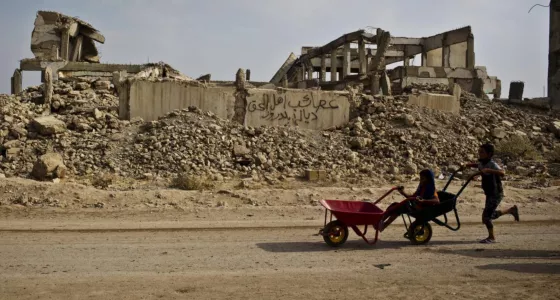Whilst 2022 will forever be remembered for the return of major conflict to Europe, this year also marks the 25th Anniversary of the Children and Armed Conflict (CAAC) agenda. It is a significant milestone, and an opportunity for us to review our progress and think about the road ahead in better protecting children from conflict. Save the Children and War Child remain firmly committed to this agenda, and we are particularly keen to see CAAC issues elevated, enhanced, and better integrated within the foreign policy and priorities of the UK.
Over the past 25 years, the CAAC mandate has directly and indirectly protected millions of children. Despite this, children continue to experience the six grave violations. They continue to be recruited into armed forces, abducted, killed and maimed, sexually assaulted, have their schools and their hospitals attacked and be denied access to life-saving assistance and services, among numerous other horrific acts.
In April War Child and Save the Children co-sponsored a Wilton Park workshop where States, UN agencies and organisations working on CAAC came together to chart a way forward for the agenda. We were privileged to hear directly from young people living through conflict about their experiences and critically their recommendations for the international community to effectively improve child protection in conflict. We agreed a roadmap for the future in the form of practical solutions and proposals. We hope that the UK will continue to demonstrate global leadership on protecting children in conflict by ensuring that the CAAC agenda is embedded across the UK’s foreign policy and military priorities.
In 2022, new – as well as protracted – conflict continues to threaten children’s rights, including their fundamental rights to live, learn and be protected. The latest outbreak of conflict in Ukraine demonstrates that war will continue to impact children for generations to come. The nature of conflict and instability has changed, and we have to find new ways to respond, we will need to go further faster to protect children trapped in some of the most dangerous places across the globe.
Before the conflict escalated in Ukraine, 160 million children already lived in high-intensity conflict zones, and more than 250,000 grave violations against children have been verified by the UN since 2005. While our government has engaged positively with this agenda to date, its overall approach lacks sufficient coherence, coordination and accountability.
The Foreign Commonwealth & Development Office’s (FCDO) new conflict strategy is a crucial opportunity to set out a comprehensive, cross-government approach that includes embedding minimum standards and awareness of CAAC issues within the FCDO; more effective partnership and coordination between the FCDO and Ministry of Defence, and stronger ministerial ownership. On this note, we are delighted that we have had such positive engagement from Minister Vicky Ford who is fast becoming a champion of all things CAAC.
The strategy should set out how the UK will use all the diplomatic, political, legal and financial levers at its disposal to hold perpetrators of grave violations against children to account. This includes committing to resourcing international investigative mechanisms and maintaining its funding to the Office of the Special Representative of the Secretary General on Children and Armed Conflict (SRSG).
It should also set out what steps the UK Government will take to galvanize support for, and strengthen the effective implementation of, the Safe Schools Declaration, the Paris Principles and the Optional Protocol to the Convention on the Rights of the Child on the involvement of children in armed conflict. There should be a commitment to include practical training on CAAC and relevant child protection standards into all military training both domestically and with allies abroad.
We also need to see a much a mobilisation of support for the thousands of children who suffer the devastating experience of being drawn into armed groups each year. Preventing their recruitment and helping children to reintegrate into their communities after being involved with armed groups should be a major commitment shared by the international community.
In the next month or so we will see the release of the annual UN Secretary Generals CAAC report. The report and its listing process is a critically important call for action, but for it to be thoroughly effective, it must be credible, objective, and evidence-based and accompanied by concrete and practical engagement between the United Nations and listed parties. Watchlist on Children and Armed Conflicts “credible list” report remains a critically valuable resource in this respect.
At Wilton Park many colleagues spoke about the need for reinvigorated approach to the collection of data around grave violations, the need for the CAAC agenda to be more proactive in the preventative space and the importance of child participation and doing more with children, not for them. Despite the bleak situation for so many millions of children in conflict, the CAAC agenda remains a beacon of hope for a better future.

